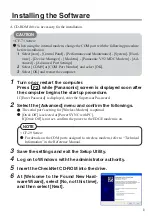
- 83 -
Your Desk
There is no specific height recommended for your desk. This can vary between 60 to 70 cm, depending upon
your size. The standard workaround is that it should be at approximately your elbow height.
The desktop should be clean and organized in such a way that frequently used objects are close enough
without excessive reaching. If you use a document holder, it should be placed at approximately the same
height as the monitor and at the same distance from the eyes to prevent frequent eye shifts.
The area underneath the desk should be clean to accommodate your legs and allow for stretching.
Your Input Devices
Note the following points when positioning your notebook computer or any external input devices.
•
Position your keyboard directly in front of you. Avoid reaching when using your keyboard or mouse.
•
If you use a mouse, position it at the same height as the keyboard and next to the keyboard. Keep your
wrists straight and use your entire arm when moving a mouse. Do not grasp the mouse tightly. Grasp the
mouse lightly and loosely.
•
Adjust the keyboard height so that your elbows are near your body and your forearms are parallel to the
floor, with your forearms resting on either armrests or forearm supports, in the manner described
previously. If you do not have armrests or forearm supports, your upper arms should hang comfortably at
your sides.
•
Adjust the keyboard slope so that your wrists are straight while you are typing.
•
Type with your hands and wrists floating above the keyboard. Use a wrist pad only to rest your wrists
between typing. Avoid resting your wrists on sharp edges.
•
Type with your wrists straight. Instead of twisting your wrists sideways to press hard-to-reach keys, move
your whole arm. Keep from bending your wrists, hands, or fingers sideways.
•
Press the keys gently; do not bang them. Keep your shoulders, arms, hands and fingers relaxed.
Your Screen or Monitor
Correct placement and adjustment of the screen or external monitor can reduce eye, shoulder, and neck
fatigue. Check the following when you position the screen or external monitor.
•
Adjust the height of your screen or external monitor so that the top of the screen is at or slightly below
eye level. Your eyes should look slightly downward when viewing the middle of the screen or external
monitor.
•
Position your screen or external monitor no closer than 30cm and no further away than 75cm from your
eyes. The optimal distance is between 35cm and 45cm inches.
•
Rest your eyes periodically by focusing on an object at least 6 metres away. Blink often.
•
Position the screen or external monitor at a 90° angle to windows and other light sources to minimise
glare and reflections. Adjust the monitor tilt so that ceiling lights do not reflect on your screen or external
monitor.
•
If reflected light makes it hard for you to view your screen or external monitor, use an anti-glare filter.
•
Clean your screen or external monitor regularly. Use a lint-free, non-abrasive cloth and a non-alcohol,
neutral, non-abrasive cleaning solution or glass cleaner to minimise dust.
•
Adjust the screen or external monitor's brightness and contrast controls to enhance readability.
•
Use a document holder placed close to the screen or external monitor.
•
Position whatever you are looking at most of the time (the screen or reference material) directly in front
of you to minimise turning your head while you are typing.
•
Get regular eye check-ups.
















































